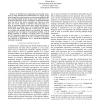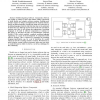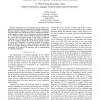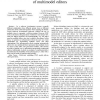MODELS
2015
Springer
8 years 7 months ago
2015
Springer
Abstract—In Model-Driven Engineering, the potential advantages of using bidirectional transformations are largely recognized. Despite its crucial function, in certain cases bidir...
MODELS
2015
Springer
8 years 7 months ago
2015
Springer
In this paper we propose an iterative process for the correct speci
cation of model transformations, i.e., for developing correct transformation models. This permits checking the ...
MODELS
2015
Springer
8 years 7 months ago
2015
Springer
Advanced driver assistance systems and (semi-)autonomous mobility systems will arguably be the biggest disruption of our everyday life in the next couple of years. The development ...
MODELS
2015
Springer
8 years 7 months ago
2015
Springer
—Component-based and model-driven engineering are key paradigms for handling the ever-increasing complexity of technical systems. Surprisingly few component models consider extra...
MODELS
2015
Springer
8 years 7 months ago
2015
Springer
—This contribution proposes a new technique for developing test cases for UML and OCL models. The technique is based on an approach that automatically constructs object models fo...
MODELS
2015
Springer
8 years 7 months ago
2015
Springer
—Model-Integrating Software Components (MoCos) use models at runtime as first class entities within components to build flexible and adaptive software systems. Building such sy...
MODELS
2015
Springer
8 years 7 months ago
2015
Springer
—This paper has two purposes: first, it discusses one approach that shows how modeling and in particular information systems modeling techniques are employed within a traditiona...
MODELS
2015
Springer
8 years 7 months ago
2015
Springer
— In a software development process, normally different stakeholders have different system views at different abstraction levels. This heterogeneity when applying the ModelDriven...
MODELS
2015
Springer
8 years 7 months ago
2015
Springer
MODELS
2015
Springer
8 years 7 months ago
2015
Springer
Abstract—Metamodels are used to define languages, code generation and they serve as data structures for metamodel-centric software systems. In software engineering, these metamo...




